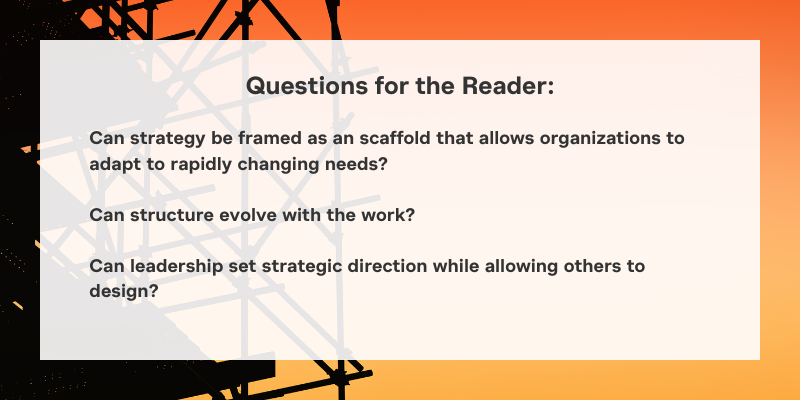For most of my career, I’ve worked with CEOs and executive teams to align structure to strategy. At AlignOrg Solutions, we’ve built our approach to organization design on a core belief: strategy leads, structure follows, and execution depends on alignment.
This method is clear, rigorous, and results-driven. It’s what our clients come to us for—and what we’ve built our reputation around.
But as someone who’s also spent time in the broader global community of organization design, I’ve found myself grappling with a growing tension. I’ve encountered voices that challenge the very assumptions our field often takes for granted—particularly when it comes to the sequence of strategy and design. Most of the time, these thinkers don’t outright reject strategy, but they do question whether it can—or should—be defined entirely at the top and imposed through cascading structures.
In this post, I want to explore that tension—not to signal a change in how we work at AlignOrg, but to invite a conversation I believe matters for the future of our discipline.
The Traditional Paradigm: Strategy as Top-Down Clarity
The dominant view of strategy has long been shaped by thinkers like Michael Porter, who defined it as a matter of deliberate positioning and trade-offs. In Playing to Win, A.G. Lafley and Roger Martin offer a highly structured strategic logic: where to play, how to win, what capabilities to build, and what systems to manage.
In this model, strategy is fixed (or at least long-term), choices are explicit, and structure is engineered to deliver those choices. Alignment becomes a function of control: the right roles, reporting relationships, and governance mechanisms.
Rupert Morrison, in his recent book Strategic Value Creation, offers a more data-rich, systems-aware version of this logic. He sees strategy as dynamic—but still modelable. Strategy informs structure, people, and processes through interconnected logic and workforce analytics. Design becomes a planning activity: enhanced by insight, but still fundamentally top-down.
This logic continues to deliver real results, particularly in environments where business models are stable, performance metrics are clear, and the need for execution speed is high.
The Complexity Challenge: Strategy as Emergence
Yet alongside this tradition, another view has taken shape—one that has deeply influenced me personally.
Henry Mintzberg has long challenged the idea that strategy is always the result of conscious planning. In his work, strategy often emerges as a pattern—something recognized after the fact rather than prescribed from the outset.
Dave Snowden, through the Cynefin framework, takes this further. In environments marked by uncertainty, interdependence and rapid change, he argues that strategy cannot be engineered in advance. It must emerge through sensing and responding. He advocates:
- Narrative-based sensemaking, drawn from field-level insights.
- Safe-to-fail experiments, rather than fail-safe implementation.
- Adaptive coherence, rather than rigid alignment.
Phanish Puranam sheds light on Decentralized Autonomous Organizations (DAOs) and decentralized organizing as a similarly provocative reframe. Rather than cascading a fixed strategy, Puranam argues for guiding microstructures through shared problems and constraints. Local units adapt their own structural choices, allowing design to emerge from within, not just from above.
What These Perspectives Offer
These complexity-informed approaches offer real promise:
- Organizations can be more adaptive in rapidly changing contexts.
- Teams have greater ownership and autonomy in executing strategic intent.
- Learning loops are tighter, and resilience increases through local experimentation.
- Strategic direction is still present—but it’s shaped in action, not fully prescribed in advance.
These are meaningful advantages, particularly for organizations navigating innovation, disruption, or systemic transformation.
The Design Trade-Offs Are Real
At the same time, I’ve seen firsthand that decentralized and emergent design models come with real challenges:
- Without shared top-level direction, organizations risk fragmentation.
- Accountability blurs when design becomes overly distributed.
- Scaling what works becomes harder—and often slower.
- The field still lacks robust, comparative data on enterprise-level effectiveness of these models over time.
I raise these points not to diminish the ideas, but because I believe any serious engagement with complexity must also contend with the demands of execution and enterprise performance.
Where I Stand
To be clear: AlignOrg’s methodology is not changing any time soon. We continue to work with CEOs and senior leaders to deliver strategy-led design, supported by proven methods, tools, and frameworks. It’s a model that has worked—and continues to work—in organizations across sectors and contexts.
But as a practitioner deeply committed to this field, I also feel a responsibility to engage with the ideas at its edges. I’m not proposing we replace what works—I’m inviting reflection on how our field might evolve to meet the world as it is: more complex, less predictable, and increasingly shaped from the ground up.
Maybe strategy is still the starting point. But perhaps it can be framed less as a script to execute and more as a scaffold to adapt within.
Maybe structure still matters. But maybe it must evolve with the work, not just reflect a fixed intent.
Maybe leadership still sets direction. But maybe its deepest impact lies in enabling others to design—not just to follow.

What’s Next
In my next post, I’ll explore what these shifts mean for authority and decision-making. If strategy and structure are increasingly emergent, who decides what—and how do we share authority without losing clarity?
This isn’t about abandoning proven methods. It’s about asking what might be next—and being willing to explore those questions with honesty, humility, and an open mind.
If you’re wrestling with these questions too, I’d love to hear from you.
Let’s design forward—together.





